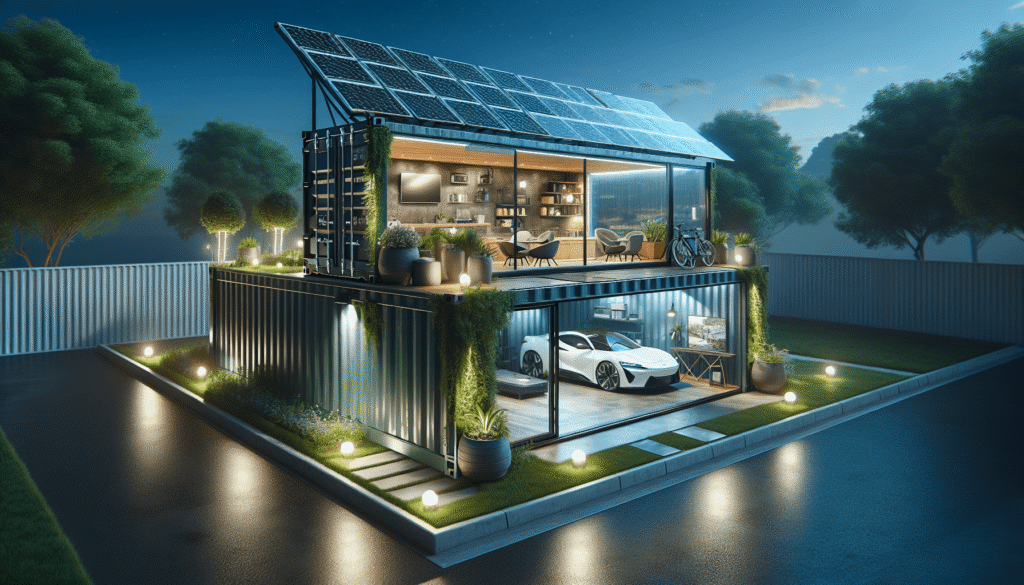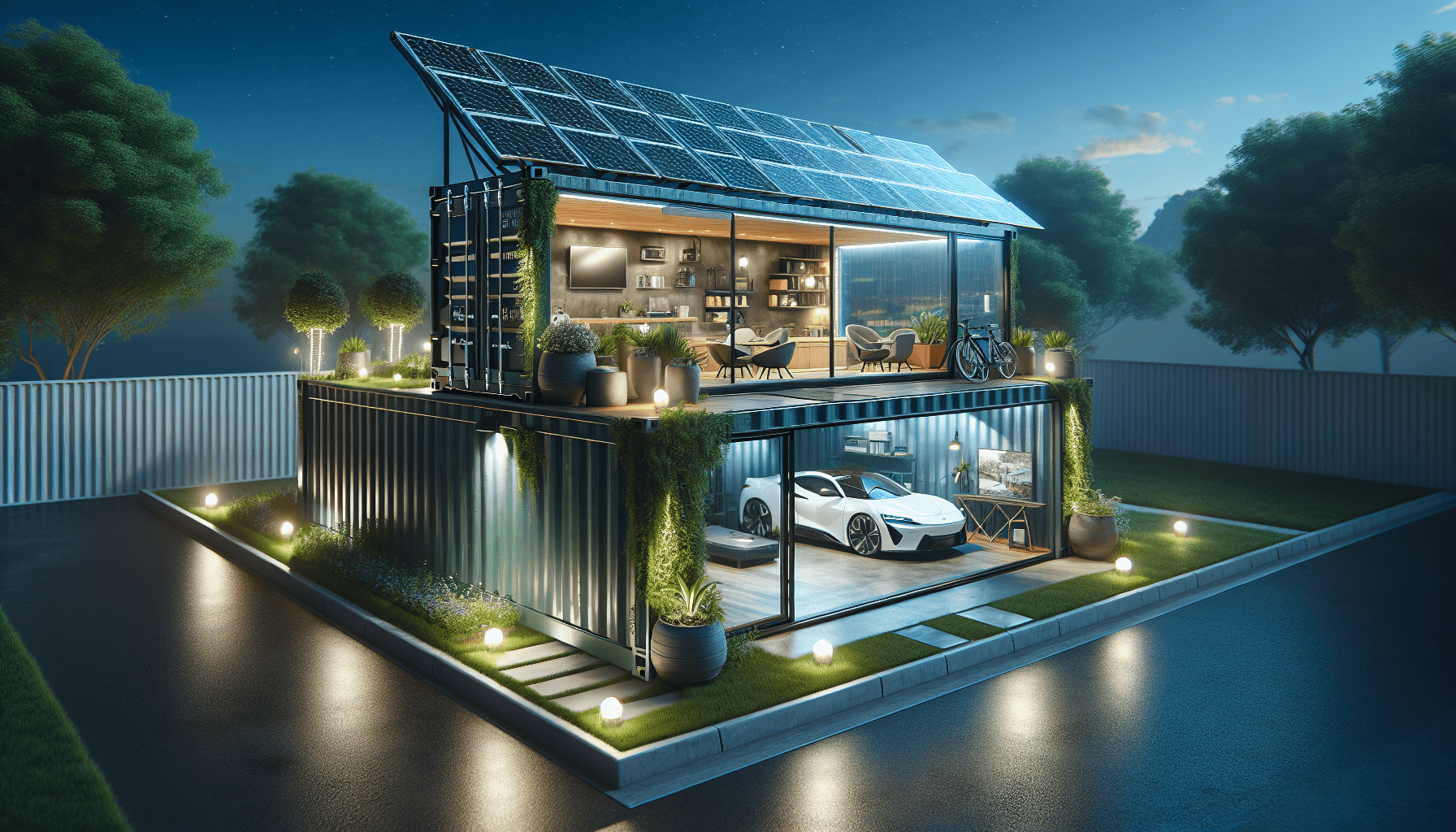Have you ever thought about the potential of shipping containers beyond just transporting goods? Recently, shipping containers have gained popularity as cost-effective, versatile solutions for various architectural needs, including modern garages. Their sturdy build, affordability, and sleek design make them an innovative choice for creating unique and functional spaces. Let’s dive into creative and practical ideas for using shipping containers to craft the perfect garage for your needs.
Understanding the Appeal of Shipping Container Garages
When you think about garages, traditional structures likely come to mind. However, shipping containers offer a unique blend of durability, affordability, and creativity. Shipping containers are made of corten steel, a weathering steel mixture designed to withstand the harsh conditions of sea transport, which makes them extremely resilient against the elements and ideal for converting into garages. Plus, they’re readily available and can be a sustainable option, often made from repurposed, decommissioned containers.
Benefits of Using Shipping Containers
Durability and Strength: Designed to carry heavy loads, withstand harsh climates, and be stacked high, shipping containers are incredibly robust. This strength ensures that your garage can endure extreme weather, keeping vehicles and stored items safe.
Affordability: Compared to traditional building methods, constructing a garage from shipping containers can be significantly more budget-friendly. This cost efficiency arises from reduced material costs and the sped-up construction timeline, as much of the foundational structure is already in place.
Eco-friendly: Recycling shipping containers into new structures can reduce the need for raw materials and the energy required to produce them, making them an environmentally conscious choice.
Versatility: With endless customization possibilities, shipping containers can be tailored to suit a variety of design aesthetics and functional requirements.
Essential Considerations Before Building
Before picking up a shipping container and converting it into a garage, there are key factors you should consider to ensure your project aligns with your goals and needs.
Choosing the Right Container Size
Shipping containers come in standardized sizes, most commonly 20 feet and 40 feet long. The container size you choose can greatly influence the cost and design of your garage. A single 20-foot container might suffice for a basic structure to house a small car or bikes, while larger setups may require combining multiple containers to create additional space for tools, a workspace, or even a workshop area.
Zoning and Permit Requirements
One of the first steps before beginning your project is to check local zoning laws and building permits. Regulations differ between cities and regions, and it’s crucial to ensure that shipping container structures are permissible in your area. Acquiring the necessary permits will help avoid costly legal issues down the road.
Insulation and Ventilation
Proper insulation is vital if you’re using your shipping container garage in variable climates to maintain a stable temperature and prevent condensation. Insulation can be added using spray foam, fiberglass, or panels. Adequate ventilation is equally essential to ensure airflow, preventing moisture buildup and ensuring the comfort of anyone using the space.
Foundation Requirements
Shipping containers need to be placed on a stable foundation to prevent sinking or shifting. Depending on your site, you might use concrete piers, slabs, or footings. The foundation must be level and strong enough to support the container’s weight. Consulting with a structural engineer can provide guidance specific to your landscaping and climate conditions.

Innovative Shipping Container Garage Ideas
With the fundamentals in place, it’s time to explore some creative ideas that can help you transform a simple shipping container into an extraordinary garage space that fits your lifestyle.
Single Car Garage
If you have limited space or only need to park one vehicle, a single 20-foot container might suffice. This setup is perfect for compact urban environments where space is at a premium. You can customize the interior storage with shelving units and tool racks to maximize organization.
Double Bay Garage
By placing two 20-foot containers side by side, you can create enough space for a double bay garage. This setup allows additional storage or workspace while accommodating two vehicles. The containers can be connected with a roofing structure to create a seamless interior space.
Workshop and Garage Combo
For enthusiasts who need a space to indulge in their hobbies, combining a garage with a workshop space is ideal. By using a 40-foot container, you can partition areas for vehicle storage and a separate workshop. Equip your workshop with a workbench, tool storage, and task lighting to make it functional.
Car Repair Station
If you love working on cars and need more space, consider using multiple containers to create a car repair station. By configuring the containers into an L-shape or U-shape, you gain more space for a hydraulic lift, additional tools, and storage, turning your garage into the ultimate DIY mechanic’s dream.
Eco-Friendly Garage
Embrace sustainability by integrating eco-friendly features into your shipping container garage. Solar panels can be installed on the roof to harness renewable energy, while rainwater harvesting systems can provide water for cleaning vehicles. Using recycled materials within the interior also adds to environmental conservation efforts.
Home Office and Garage Hybrid
For those who need a multifunctional space, combining a garage with a home office can be a practical solution, especially if working from home has become the norm. The office area can be built on top of the shipping container, offering a quiet retreat separate from the home, with the garage below for easy access to vehicles.
Design and Aesthetic Considerations
Creating a shipping container garage doesn’t mean sacrificing design. On the contrary, the flexibility of containers allows for a vast array of styles to choose from, integrating them seamlessly with their surroundings.
Exterior Design
Shipping container garages can be designed to complement existing architecture in their environment. Cladding materials like wood paneling, metal sheets, or brick facades can be added to the exterior for a more traditional look. Painting the containers with high-quality exterior paint not only protects them but also adds aesthetic value.
Interior Design
The interior of your garage can be tailored to meet your specific needs and tastes. Whether you prefer a rugged, industrial feel with exposed steel walls or a streamlined, modern style with finished walls and floors, the choice is yours. Utilizing creative storage solutions and efficient space planning is crucial for maintaining functionality.
Lighting Solutions
Lighting plays a crucial role in both the functionality and atmosphere of your shipping container garage. Natural light can be introduced through skylights or glass doors, reducing the need for artificial lighting during the day. For nighttime or low-light conditions, consider installing LED lighting – they are energy-efficient and provide excellent illumination.

Enhancements and Upgrades
Once your shipping container garage is set up, consider adding enhancements that can improve functionality or comfort.
Security Features
Secure access to your garage by installing robust locks and, if needed, an advanced security system comprising cameras and motion detectors. Steel doors or reinforced shutters can provide added protection against unauthorized entry.
Climate Control
Depending on your climate, adding a climate control system—such as heating for winters or cooling for summers—may be beneficial. This ensures your garage is comfortable year-round and protects your vehicle and tools from extreme temperatures.
Smart Features
Modern technology can elevate the functionality of your shipping container garage. Smart garage door openers allow convenient access via smartphone, while integrated lighting and climate control systems give you greater control over the environment.
Cost Estimation and Budgeting
Typical Costs Associated With Shipping Container Garages
It’s important to recognize the various costs involved with creating a shipping container garage, including container purchase, delivery, foundation preparation, permits, insulation, and interior design. Here’s an estimated breakdown for a basic setup:
| Item | Estimated Cost Range |
|---|---|
| Container Cost | $2,000 – $5,000 (per 20-foot) |
| Delivery Fee | $500 – $1,500 |
| Foundation Setup | $1,000 – $4,000 |
| Permits | $100 – $500 (Depending on locality) |
| Insulation | $1,000 – $3,000 |
| Interior Fitting | $2,000 – $10,000 |
| Miscellaneous | Variable |
Budgeting Tips
To manage costs effectively:
- Compare prices from multiple suppliers for containers to get the best deal.
- Consider used containers for a more budget-friendly option.
- DIY some of the interior work if you have the skills, such as painting or shelving installation.
- Plan your design carefully to avoid costly changes during construction.
Conclusion
Shipping container garages offer a novel approach to car storage and workspaces, combining durability, affordability, and eco-friendliness with a dash of design-forward thinking. Whether you’re looking to save on construction costs, expand your garage’s functionality, or simply embrace a modern, industrial style, the possibilities are as vast as your imagination. With careful planning and consideration, you can create a space that fully meets your needs while standing out as a testament to innovative thinking and sustainable practices. What’s your vision for transforming a steel box into a functional and stylish garage?

